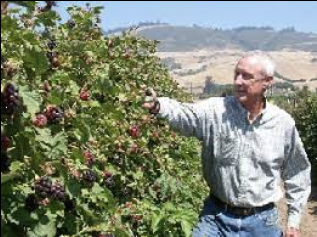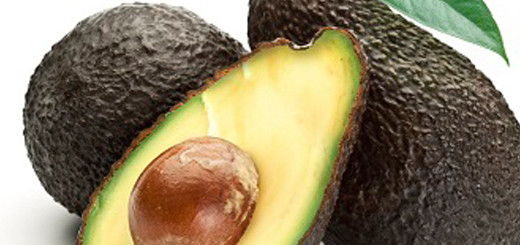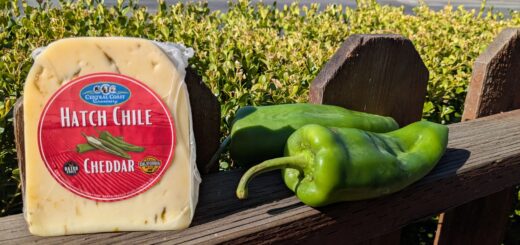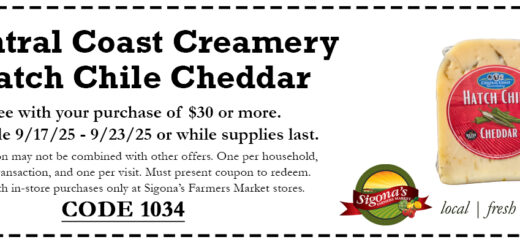Oh, Berry! Boysenberries and Olallieberries in at Sigona's!
Oh, Berry!
Hurry in for fresh-picked boysenberries and olallieberries from Vince Gizdich’s ranch in Watsonville, CA. These roadside fruit stand favorites are in now at Sigona’s.
By Robbie Sigona
When is the last time you had a boysenberry? No, not a boysenberry syrup or jam, but a real, fresh-picked boysenberry.
Fresh boysenberries are a rare commodity. Not a lot of farmers grow them anymore because they’re fragile and were not bred for traveling long distances. However, Vince Gizdich, a local farmer in Watsonville, Calif., grows them, and with three generations of berry-growing expertise on his side, he grows some of the best boysenberries around.
We’ve worked with Vince for about 35 years and it’s these berries, along with his heirloom apples, that have put Gizdich Ranch on the map.
At their peak, boysenberries turn a glossy, reddish black color and have a tart-sweet flavor similar to a ripe raspberry. The telltale sign of a perfectly ripe, succulent and sweet boysenberry is when it’s leaking – or bleeding – its juice. Understanding this is key to guaranteeing yourself the best boysenberry experience.
“Most people are quick to think that bleeding berries are past their prime, but that’s when they’re best” said Vince. “Breaking that belief is hard, especially with people who purchase berries from supermarkets; those berries are bred for traveling and a long shelf life. You can bounce those off the wall and they’ll still be good for a week, but they’re no where near as sweet. That’s why boysenberries are usually found at farmers markets or roadside stands like ours.”
The strawberries taste like strawberries, and the olallieberries taste like olallieberries!
Vince also grows olallieberries, a sweet-tart blackberry derivative that’s a cross between a Loganberry and a Youngberry. When picked at their peak, they taste better than the best berry jam.
Olallieberries were originally developed in Oregon in the early 1930s, but California has been responsible for the majority of production. They thrive along the cool coastal areas between Half Moon Bay and Monterey. They were not bred to last – and they have an extremely short season – so to eat them fresh, you have to act fast. Otherwise, look for them in jams or pies.

The tart zing of the olallie makes them absolutely perfect for pies and fruit crisps. My Grandpa Sigona also grows some of his own olallies and makes the best olallieberry pie. He freezes them, too, so we’re able to enjoy them throughout the year.
Aside from its famous artichoke soup, Duarte’s Tavern in Pescadero, where olallieberries flourish, has built its legendary reputation on the strength of its award-winning olallieberry pie. The recipe has been passed down for three generations, and in 2005 Life Magazine honored it with the “best pie” designation. A trek to Pescadero is a must-do, but if you have a hankerin’ and don’t have the time, we carry frozen Duarte’s olallieberry pie at both locations.
We also carry our own olallieberry jam. It will knock your socks off! Put a dollop of that on a triple crème brie-topped cracker or baguette and you have yourself a sinfully delicious snack.
Oh yes, we use the boysenberries in our own Sigona’s creations, too. Two summers ago we introduced Sigona’s Bleeding-Ripe Boysenberry Gelato, a flavor formulated by the true Italian gelato mastermind himself: Massimo Caporale of Massimo Gelato. He used Vince’s boysenberries to come up with this flavor-packed gelato, and if you haven’t tried it yet, we hope you do this summer. It’s deliciously sweet, cool and refreshing, and is even better with a few fresh boysenberries sprinkled on top. You can read more about their partnership here.
“The boysenberry is a very sweet, great berry with a short season,” said Vince. “I hope more people give them a try to see for themselves how truly juicy and sweet they are.”
We hope so, too, as the berry will only stay around as long as people continue to buy them. We love having heirloom varieties of fruits & vegetables, and supporting the small farmers that continue to work these gems. We thank you for supporting them, too.














